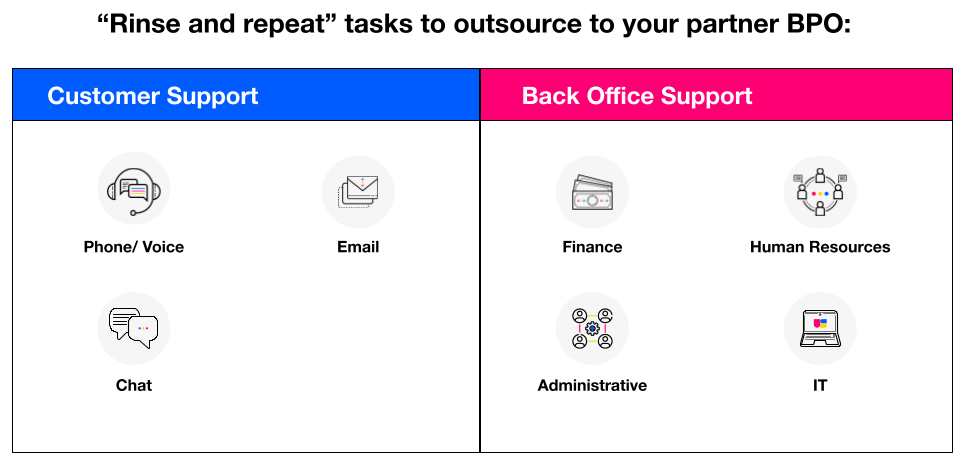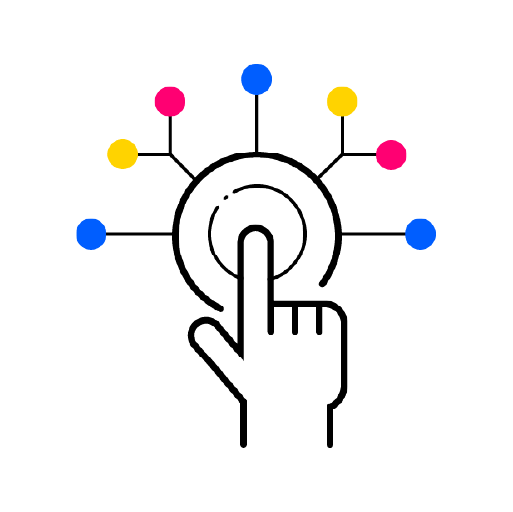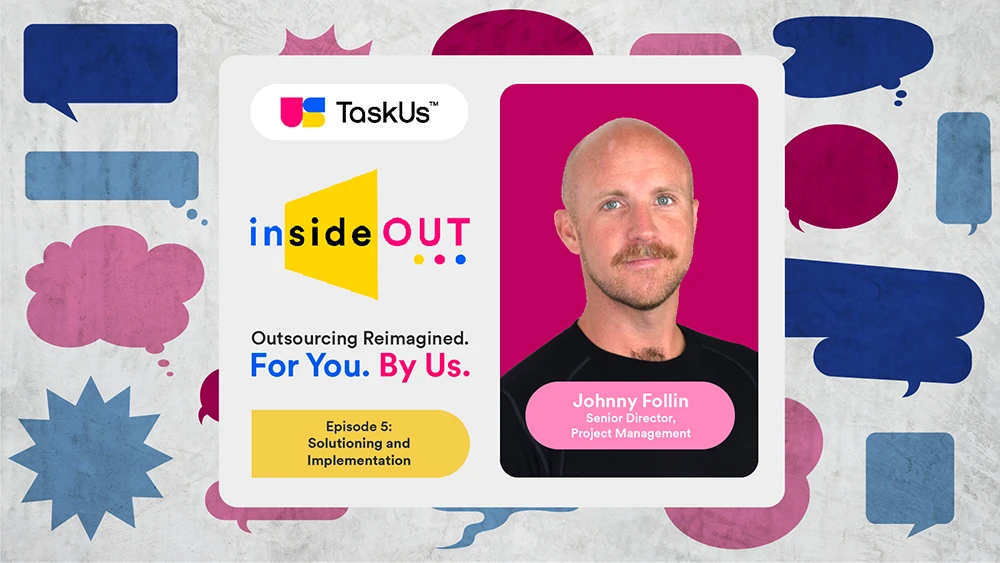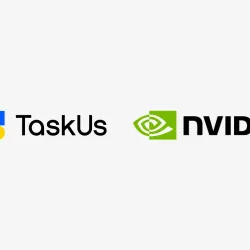Industry Knowledge
Outsourcing Process Simplified: The What’s, Why’s, and How’s
TaskUs’ Senior Director of Project Management, Johnny Follin, answers the biggest questions about solutioning and implementation on Inside Out.
- What tasks should you delegate to your outsourcing partner?
- What kind of tasks should you outsource?
- Which is better: An outsourcing partner that is remote or physically close?
- How do you select the best location for your outsourcing operations?
- What is the difference between dedicated and shared agents?
- What are the preparations needed when starting the outsourcing process?
- Who’s going to support you during the entire outsourcing process and implementation?
- What is the typical implementation timeline?
- Making the Outsourcing Process Ridiculously Good From Prep to Launch
- With Us, you can count on a solid yes.
As businesses and industries evolve, staying ahead of the competition requires a constant effort to scale and streamline operations. One of the popular ways of doing so is through outsourcing. But for many businesses, the thought of outsourcing can be overwhelming. TaskUs launched Inside Out: an online series where leaders talk about everything businesses need to know about outsourcing—from understanding the outsourcing process to creating an effective, nuanced, and agile outsourcing implementation plan.
In the latest episode of Inside Out, TaskUs Senior Director of Project Management Johnny Follin discusses the most critical elements businesses need to know about the outsourcing process and implementation phase.
What tasks should you delegate to your outsourcing partner?
As with any business plan, defining your outsourcing goals is the first step in the outsourcing process. This means taking the time to reflect on your current operations and setting clear goals. Generally speaking, any business would aim to achieve process optimizations and cost savings regarding outsourcing. With that in mind, Follin notes that “the best tasks to outsource are those that can be considered rinse and repeat.”

Partnering with a business process outsourcing (BPO) company and subscribing to the outsourcing process is a great way to hand off daily tasks, such as customer support or back office duties. This way, you can focus on your core business while your outsourcing partner handles customer experience and back office solutions.
What kind of tasks should you outsource?
It’s best to target repeatable and standardized tasks for your outsourcing operations primarily. For customer support, it could be tracking shipments or answering frequently asked questions (FAQs). Many back office tasks can also be outsourced, such as content moderation, image retouching, data entry, and transcription.

Which is better: An outsourcing partner that is remote or physically close?
Generally speaking, most outsourcing providers offer both work-at-home (remote) or in-center (physical) options in their outsourcing operations. While both options provide noteworthy and sustained benefits, choosing one over the other ultimately depends on the business’s needs.
Remote BPO operations can mean greater flexibility and wider talent sourcing. They are generally seen as an added value to employees. Remote operations also cost less as they reduce overhead expenses. On the other hand, in-center operations can mean better security, especially tasks involving sensitive customer data.
How do you select the best location for your outsourcing operations?
Onshore, nearshore, and offshore all refer to the physical distance of your outsourcing operations from your business’s location. For example, if your business is based in the US:
- An onshore outsourcing partner should be operating within the US;
- Nearshore BPOs are those based within a short distance like Mexico and Canada; and
- Offshore locations are those in far distances like the Philippines, India, and Malaysia.
Regardless of the location, all offer the same services with varying advantages. Follin explains the best way to understand each: “Distance and costs are closely related, with offshore operations being the most cost-effective, followed by nearshore, and then onshore. Onshore operations are better suited for more complex, technical work.”
| Onshore $$$ | Nearshore $$ | Offshore $ |
|---|---|---|
|
|
|
Selecting the location for your BPO operations will largely depend on the costs and the tasks you need to outsource. An onshore partner will generally have a more significant advantage when it comes to culture and language, while making complex operations easier to supervise. Offshore partners, on the other hand, are an excellent choice for cost savings and back office work.
What is the difference between dedicated and shared agents?
Dedicated agents work for only one client at a time while shared agents work for multiple clients simultaneously, and may work a few hours a day or a week, depending on workload. For BPO recruitment, dedicated agents handle more complex work and have a deeper understanding of your business and processes. Shared agents have limited to a smaller scope of work, as they would support different client operations simultaneously.
| Dedicated Agent | Shared Agent |
|---|---|
|
|
What are the preparations needed when starting the outsourcing process?
The specifics may vary for every business, but at a high level, you should prepare a job description, training materials including presentations and assessments, volume data like call and email volumes at different intervals, and a Uniform Resource Locator (URL) tools list which specifies what software and tools an agent will need to use and access.
Items to prepare:
- Job description
- Training agenda and materials
- Volume data (call and email for 30-60-90 days)
- URL tools list
Who’s going to support you during the entire outsourcing process and implementation?
The implementation process follows PMI's best practices with the following phases: Initiation, Planning, Execution, and Closing.
 1. Initiation |
The PM will have to complete the necessary discovery calls during the initiation phase to fully identify the client’s requirements. |
 2. Planning |
The planning phase includes weekly project meetings to ensure all deliverables are tracked and completed following the project timeline. |
 3. Execution |
The execution phase includes the training launch, where the agents are trained on the client’s processes. |
 4. Closing |
The implementation phase concludes with the PM presenting lessons learned and formally handing over the operations to the assigned Client Services and Operation partners. |
What is the typical implementation timeline?
Timelines will vary depending on the client’s needs, but generally speaking, most implementations last 30-45 days from contract signature to launch date. Recruitment, hiring, onboarding, and language requirements generally determine the implementation timeline.
Making the Outsourcing Process Ridiculously Good From Prep to Launch
Now that you have a better idea of preparing for your outsourcing operations, the next step is knowing what to look for in a BPO outsourcing partner.
- Do they provide flexible solutions for your best interests?
- Do they have the expertise and BPO technology to make the outsourcing process easy?
- Are they a proven and reputable partner who has helped other businesses reach their goals?
With Us, you can count on a solid yes.
Recognized by the Everest Group as the World’s Fastest Growing Business Process (outsourcing) Service Provider in 2022 and quickly gaining popularity in Gartner Peer Insights Review, TaskUs makes the BPO process Ridiculously Efficient with our end-to-end outsourcing solutions—from customer experience consulting to risk and response solutions.

References
We exist to empower people to deliver Ridiculously Good innovation to the world’s best companies.
Services







